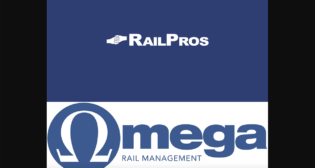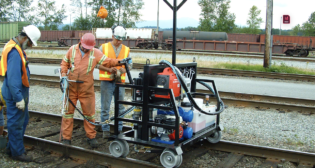
What’s the rub?
Written by William C. Vantuono, Editor-in-ChiefRolling contact fatigue, spalling, excess noise, and a host of other less-than-ideal effects can afflict rail, but all may be dealt with by developing a friction management program. Today’s service providers are looking at total cost of ownership concerning their equipment and services, increasing unit uptime, and developing a friction modifier that spreads easier and can be refilled quickly to help customers reach new levels of efficiencies.
L.B. Foster Co. says it has taken a unique approach in working with its customers to evaluate Friction Management (FM) solutions using a Total Cost of Ownership (TCO) model and continues to partner with each customer after installation is complete using its Field Services team.
The company begins the TCO process by understanding the goals each potential customer is trying to achieve and its specific operating conditions and then tailors product and equipment solutions to optimize results. Factors such as gradient, traffic levels, and rail profile management are among operating conditions taken into account by L.B. Foster’s product solution experts.
“The key to the connection between customer goals and product solutions is our deep understanding of wheel/rail interaction dynamics and economic modeling,” says Brian Vidler, senior manager product solutions. “We recently developed KELTRACK® ER, which is a true TOR friction modifier that carries twice as far as our standard KELTRACK product. We also have a new TOR oil product that carries up to eight miles on level grade. This is twice the distance of materials currently available. These advances in TOR consumables have several important economic benefits for customers. For example, there is a reduction in overall spending for consumables. There are also ancillary benefits from a reduction in the number of application systems required—saving the customer capital—as well as savings from shipping and reduced refilling.”
From the application equipment standpoint, L.B. Foster says the key factor that leads to lower TCO is uptime and points out two complimentary routes to achieve longer uptime: Reliable, efficient equipment and establishing a service and maintenance plan.
Says Vidler, “We continue to develop new equipment designs that build on our reputation for dependability. We have also improved access for ease of maintenance to bring equipment back on line faster. In addition, we have invested heavily to develop new, more-efficient applicator bars. This results in less product waste and a corresponding lower TCO. Our new Grease Guide and TOR Foam Bar are two examples.”
As far as establishing a service and maintenance plan, L.B. Foster says the company leverages its Field Service group in designing and providing maintenance and filling services. Using the company’s Remote Performance Monitoring (RPM) technology, equipment operating conditions are evaluated in order to schedule predictive, rather than reactive, maintenance. Coupled with Field Services, the company has been able to demonstrate more than 90% unit uptime.
General Manager Jim Tanner reports, “We continue to add headcount and increase our investment in fixed assets to expand our Field Service capabilities to bring additional value to our customers. Among the many services that we provide are initial surveys to decide where to locate our equipment and to determine appropriate FM application rates. And we continue to work with our customers through the entire order process, as well as equipment installation. Our customers are also engaging us to provide ongoing service and equipment maintenance in addition to supplying our consumables via bulk filling to maximize FM benefits. Further, we have partnered with other L.B. Foster teams in our Salient Systems and Car Repair businesses to bring an expanding package of service offerings.”
Loram Maintenance of Way, Inc. General Manager-Friction Management Jon Behrens believes that friction management “is a key cost effective solution that provides increased rail life and reduced fuel consumption. Product development remains a primary focus, and we continue to explore customized solutions while growing our footprint in the friction management marketplace. Development of application and delivery systems as well as modifier advancements will continue to occur at a rapid pace to ensure the reliability and effectiveness of our friction management solutions and the complete customers satisfaction.”
Loram has installed more than 1,000 TOR delivery systems on Class I’s in the past two years and expects its installed equipment base to increase significantly in 2014.
“Proper friction management practices allow railroads to improve the stress state of their infrastructure by controlling track forces and friction,” says Behrens. “Loram’s patented systems utilize customizable controllers and dual positive displacement pumps to ensure that the precise amount of friction modifier is applied to each rail. Our system is flexible enough so customers can adapt one system to changing friction modification needs based on specific site demands.”
Loram introduced a remote monitoring and analytics service program in 2013. The service includes hardware and software that is integrated with the wayside controller. According to Loram, this technology has the ability to report system operating diagnostics such as pump revolutions, modifier level, battery voltage, and many other items. The data is analyzed by Loram, which then communicates when and where maintenance is needed to its customers. In order to increase friction modifier unit up-time and realize the predicted return on investment, Loram says the remote monitoring system also allows remote functionality such as updating software, turning the system on and off, and adjusting settings and modifier disbursement.
MPL Technology, Inc., says the wheel/rail interface is an area that can further benefit from additional friction management. The company has worked with its customers to expand the benefits of its solid polymer lubricants from the wheel flange to the tread and TOR.
“MPL’s current TopStick flange lubrication line provides several benefits in friction management, including reduction in wheel and rail wear, noise, and fuel expense,” says Product Manager Ryan Mitrovich. “By applying the MPL TopStick system from an on-board dispenser, the entire right-of-way will benefit, not just curves from wayside TOR systems.”
TopStick applicators are truck-mounted on both sides of the lead car, applying a friction modifier to the tread of the lead wheels. As the sticks are consumed, the friction modifier is distributed back along the top of the rail to the rest of the train. MPL says new applicators can be installed in less than 30 minutes, refilled in less than five minutes, and are capable of applying enough friction modifier material to cover 1,000 to 1,500 miles. The applicators are powered with pneumatic cyclers using an auxiliary air line from the locomotive.
“Our solid polymer friction modifier helps to overcome difficulties encountered with previous onboard spray systems including clogging, build-up, or freezing, and with a fully consumable stick there is no mess involved,” says Mitrovich.
MPL says the TopStick system has been successfully tested at TTCI. “Testing was conducted using a combination of mechanical and electrical measurements on two locomotives with 30 loaded hopper cars while operating on the Wheel Rail Mechanism Loop. Coefficient of friction on the top of rail was monitored throughout the testing and consistently reached the AAR standard for TOR lubrication. Testing to-date has been conducted on coal cars, and prototype systems for intermodal well cars have been developed for testing and evaluation purposes. The system can be modified to accommodate most any type of car,” says Mitrovich.
Interflon USA produces Fin Lube, described as “a long-lasting, ultra-low friction technology that includes re-engineered Teflon® material for application on slide plates, track joints, and rail curves. Fin Lube is a combination rail cleaner and coating that can be applied in most weather conditions and is dry to the touch.”
Fin Lube includes micronized Teflon, called MicPol, which can penetrate the pores in steel and adhere to the metal, creating a protective coating. “Current concerns of our rail clients are much different from previous years due to worldwide environmental legislation impacts, increased rail demand and traffic, train performance/punctuality, less time to maintain, and less money and manpower being available due to budget constraints,” says Managing Director Otto Oosterwijk. “Railways are now starting to look at smarter life cycle cost decisions that are having a true impact on performance and punctuality.”
Interflon says its products have been tested and are in use on British railways, resulting in safety and operating improvements. For example, before Fin Lube is applied to a switch plate, the plate undergoes a deep clean that can reveal defects. Fin Lube is transparent and clean, allowing maintenance workers to visually check switch condition. It does not have an adverse effect on rail pads and will not change viscosity with temperature fluctuations.
While reduced noise levels and track wear are benefits, Interflon says its products can be applied to bi-directional switches initially designed for single-direction traffic to protect entry and exit points from wheel flange fatigue. The company also works with Simalube applicators, which are cartridges with a time setting that can be installed on grease nipples to supply grease for a period of up to one year.
Oosterwijk recognizes that adopting new technology can be met with concern over higher initial cost, but he points to savings realized through reduced frequencies of application and reduced quantities of product needed as two reasons railroads should consider when considering new technology.



